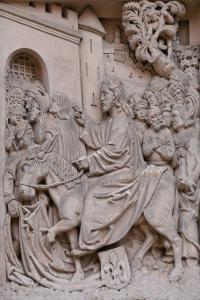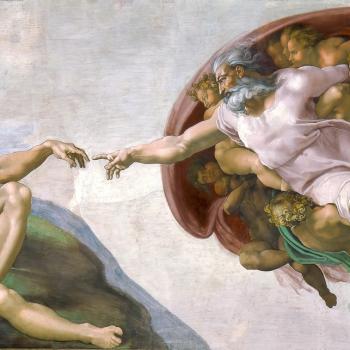 I’ve got some bad news for you cat lovers. How many times do you think cats are mentioned in the Bible? Only twice! It may well be because the Israelites eschewed everything Egyptian – after 430 years of slavery there – and the Egyptians worshipped cats. So, the mouser of choice in ancient Israel was the house weasel. You dog lovers are in better shape; dogs get 40 mentions in the Bible. But, if you own a donkey, you should be really happy; they are mentioned 444 times!
I’ve got some bad news for you cat lovers. How many times do you think cats are mentioned in the Bible? Only twice! It may well be because the Israelites eschewed everything Egyptian – after 430 years of slavery there – and the Egyptians worshipped cats. So, the mouser of choice in ancient Israel was the house weasel. You dog lovers are in better shape; dogs get 40 mentions in the Bible. But, if you own a donkey, you should be really happy; they are mentioned 444 times!
A. Some Donkey Stories
- Balaam’s Ass
In several of the great bible stories, the best supporting actor award, in my opinion, should go to the donkey; and in one story, she – for it says specifically that it was a she – gets best actress award. Let me begin with that one, though it is not the earliest. It can be found in the Book of Numbers 22:21-38.
She is a talking donkey. And not just a talking donkey who can say, “mama” and “dada” and “fetch me a carrot” but an educated ass well versed in religious debate. Here’s the backstory. The Israelites have reached Moab, which is northeast of the Dead Sea, on their journey from Egypt to the Promised Land. The king of Moab – Balak – was scared by the size of the Israelite horde and decided to engage some divine help. So, he sent messengers, promising great rewards, to Balaam, an Ammonite renowned for his divination skills, to come and curse the Israelites. Balaam consults his divination paraphernalia and, initially, is told by God not to accompany these men back to Moab. So, he sends them away. Getting more and more concerned about the Israelites, Balak sends a second delegation with promises of even bigger rewards. Balaam goes back to his “Ouija board.” Now, God changes His mind, “That night God came to Balaam and said to him: If these men have come to summon you, go back with them; yet only on the condition that you do exactly as I tell you. So the next morning when Balaam arose, he saddled his donkey, and went off with the princes of Moab.” So, he sets off on his Don Quixote donkey, only for God to have another re-think and get mad with him, “But now God’s anger flared up at him for going.”
God stations an angel in the road to block his way but only the donkey can see the angel. Three times the donkey takes evasive action in order to circumvent the sword-carrying angel, squeezing Balaam’s leg against a stone wall in the process. Balaam applies the stick to the willful ass. Finally, with absolutely no space to maneuver around the winged heavenly hitman, the donkey lies down on the road with Balaam still aboard. The following lively debate then takes place, initiated by the donkey, “’What have I done to you that you beat me these three times?’ ‘You have acted so willfully against me,’ said Balaam to the donkey, ‘that if I only had a sword at hand, I would kill you here and now.’ But the donkey said to Balaam, ‘Am I not your donkey, on which you have always ridden until now? Have I been in the habit of treating you this way before?’ ‘No,’ he replied. Then the LORD opened Balaam’s eyes, so that he saw the angel of the LORD standing on the road with sword drawn; and he knelt and bowed down to the ground.” (One hopes that Balaam’s ass went on to have a very successful career in the Roman Circus.)
2. Abraham
An earlier story speaks of Abraham setting out on a three-day journey to sacrifice his 12-year-old son, Isaac, at Yahweh’s insistence. Abraham takes two servants, a knife, fire and firewood for an altar which he will make from stones at the site of the sacrifice. Isaac, unknowingly, will be the victim. And, in the supporting role, is the donkey. Presumably the donkey’s function is to carry the firewood. The sure-footed beast is a great match for hilly terrain. They are still the transport of choice when trekking up and down the Grand Canyon.
3. Jesus
About 2,000 years later, on the self-same hilltop, another human sacrifice would take place. It, too, is going to need a victim and wood and a donkey. This time the wood will be in the form of a cross and the victim and the donkey will be the same person – Jesus. He will be his own donkey, carrying the wood of the sacrifice; and he will also be the sacrifice.
Being willing to become a donkey – to make an ass of himself – is part of the sacrifice. St. Paul got it right when he said in his letter to the Philippians, “Although he was God, he did not cling to his divinity but humbled himself…” Indeed he did; from God to human to donkey.
Just five days earlier, another donkey won the award for best supporting actor during the Palm Sunday ragtag procession into Jerusalem. As Pilate was making his magnificent, intimidating entrance through the Western gate of the city on his own war-horse, dressed in military uniform, Jesus was seated on a borrowed donkey picking its way delicately in through the Eastern gate of the city. From the sublime to the ridiculous.
Jesus and the donkey were no strangers to each other. This was to be his last journey on donkey-back. He probably didn’t remember his first one, which had taken place some 30 years earlier. As a newborn, he was being hurried into exile by his terrified parents seeking to escape an earlier, politically-planned child sacrifice. Herod or Pilate? One of them was sure to get him.
4. Samson
In the Book of Judges, Samson, in one of his ubiquitous vendettas against the Philistines, used the jawbone of an ass to kill 1,000 of them. Then he joked, “I have made donkeys of them.” Mission accomplished, he discarded the jawbone and, thereafter, the place was known as “Ramath Lehi” (Jawbone Hill.)
5. Francis of Assisi
We read in the Book of Deuteronomy 22:10, “Do not plow with an ox and a donkey yoked together.” I wonder if St. Francis was in breach of this commandment when, on Christmas 1223 CE, he invented the crèche and set a real live ox and donkey side by side at the manger of the Infant Jesus?
6. The Greeks
The Greeks have a teaching story about a beloved king who, once a month, paraded through the streets of his capital to afford his worshipful subjects the opportunity to gaze upon his splendor. For many years, his trusted steed was a donkey but, eventually, the donkey died and was replaced by a younger one. On his first trip, the young donkey is thrilled at the adulation being accorded him and begins to blush. The applause grows in volume and the donkey reckons he is obliged to acknowledge this, so he stands up on his back legs to wave at the crowd, whereupon the king is thrown to the ground and breaks his leg. The enraged crowd quickly beats the donkey to death. It’s the Greek version of “The ego thinking it’s the soul.”
7. My Great-grandmother
In Ireland, all of the donkeys have a thick black line running down the center of their backs from the neck to the tail; and another black line running down the outside of both front legs. Maybe these markings are peculiar to a particular breed favored by Irish farmers? In any case, my great-grandmother told me that this was a special mark, a cross of gratitude, bestowed by God on this gentle beast for carrying His only son into exile in Egypt to escape the “slaughter of the innocents.”
B. Palm Sunday – Jesus Makes an Ass of Himself
The Palm Sunday (Passion Sunday) scene described in the gospels is a very powerful juxtapositioning of secular and spiritual powers. Each Passover, the Roman Governor would lead his troops from Caesarea Philippi through the Eastern Gate of Jerusalem to take up occupation of the Fortress Antonia that directly overlooked the Temple Courtyard, to keep an eye on the restive Jews. For the duration of the feast the population of Jerusalem would swell from 40,000 to one-and-a-half million people – a huge tented “slum” surrounding the Holy City. This, as you can well imagine, made the Romans very nervous, so they made a great display of showcasing their military might.
And here comes Jesus, riding on a borrowed donkey, in a simple, seamless tunic woven by his mother, through the Eastern Gate, accompanied by a disorganized noisy crowd. The only weapons on display? Palm branches.
Looking upon these two characters – Pilate and Jesus – which of them would the casual observer have imagined would be lovingly remembered two thousand years later?












